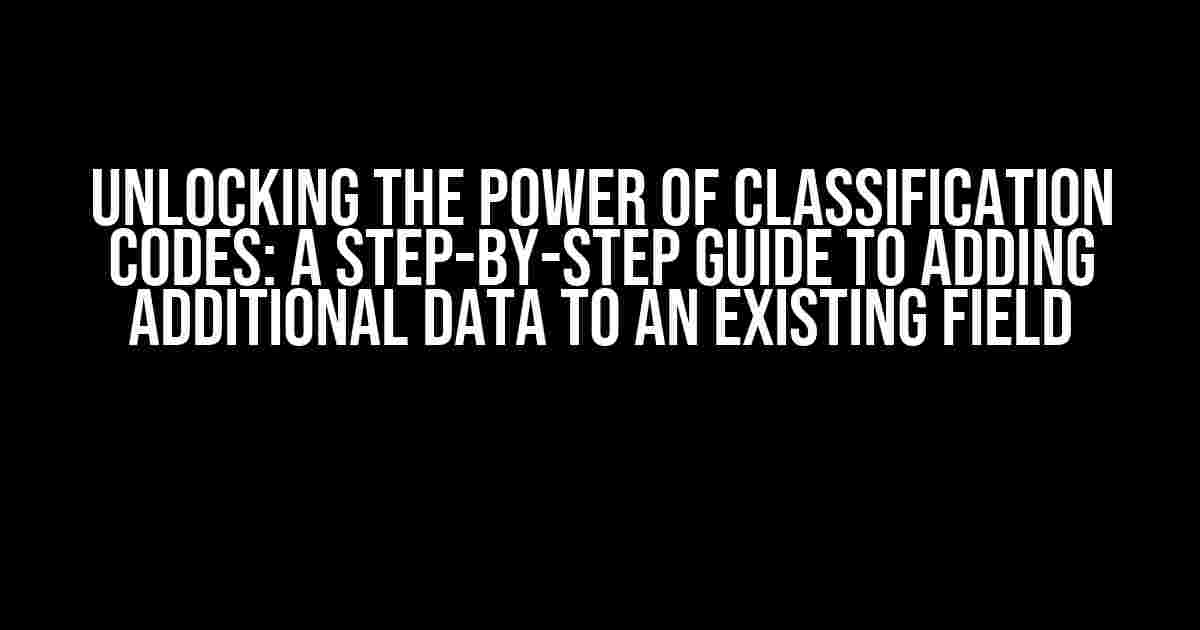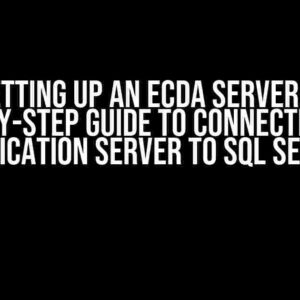Are you struggling to categorize and organize your data effectively? Do you wish to add more context to your existing fields without creating new ones? Look no further! In this comprehensive guide, we’ll explore the wonders of classification codes and show you how to add additional data to an existing field with ease.
What are Classification Codes?
Classification codes are standardized labels or tags used to categorize and describe data. They provide a way to assign meaning and context to specific fields, making it easier to filter, search, and analyze data. Think of them as digital labels that help you identify and categorize your data with precision.
Why Use Classification Codes?
Classification codes are essential for efficient data management and analysis. Here are just a few reasons why:
- Improved data organization: Classification codes help you categorize data in a logical and consistent manner, making it easier to locate and reference specific information.
- Enhanced data analysis: By adding context to your data, classification codes enable you to perform more accurate and nuanced analysis, leading to better insights and decision-making.
- Increased data consistency: Classification codes promote data consistency across different datasets and systems, reducing errors and inaccuracies.
- Faster data retrieval: With classification codes, you can quickly and easily retrieve specific data points, saving you time and effort.
Preparing Your Existing Field for Additional Data
Before adding classification codes to your existing field, it’s essential to prepare the ground. Here are some steps to follow:
- Review your existing field structure: Take a closer look at your existing field structure and identify areas where you can incorporate classification codes. Consider the type of data you’re working with, the level of granularity you need, and the overall data model.
- Clean and normalize your data: Ensure your data is clean, consistent, and free from errors. Normalize your data to ensure it’s in a format that can be easily analyzed and processed.
- Define your classification code schema: Determine the classification code schema you’ll use, including the code structure, labels, and descriptions. This will help you maintain consistency across your data.
Adding Classification Codes to an Existing Field
Now that you’ve prepared your existing field, it’s time to add classification codes! Here are the steps to follow:
Method 1: Using a Separate Column
One way to add classification codes is by creating a separate column for each code. This approach is ideal when you need to add multiple codes to a single field.
| Existing Field | Classification Code Column |
|---|---|
| Product Name | Product Category (e.g., Electronics, Fashion, etc.) |
| Customer Location | Region Code (e.g., North, South, East, West, etc.) |
| Product Name | Classification Code Column |
|-------------|---------------------------|
| iPhone 13 | Electronics |
| Nike Shoes | Fashion |
| Samsung TV | Electronics |
| Adidas Shoes | Fashion |
Method 2: Using a Concatenated Field
Another approach is to concatenate the classification code to the existing field using a separator. This method is suitable when you need to add a single code to each field.
| Existing Field | Classification Code |
|--------------------------|--------------------|
| iPhone 13_Electronics | |
| Nike Shoes_Fashion | |
| Samsung TV_Electronics | |
| Adidas Shoes_Fashion | |
Method 3: Using a Hierarchical Structure
If you need to add multiple levels of classification codes, consider using a hierarchical structure. This approach is ideal for complex data models.
| Existing Field | Classification Code Level 1 | Classification Code Level 2 |
|--------------------------|------------------------------|----------------------------|
| iPhone 13 | Electronics | Smartphones |
| Nike Shoes | Fashion | Footwear |
| Samsung TV | Electronics | Home Entertainment |
| Adidas Shoes | Fashion | Footwear |
Best Practices for Classification Code Management
To ensure maximum efficiency and effectiveness, follow these best practices for classification code management:
- Use standardized codes: Establish a standardized set of codes across your organization to maintain consistency and avoid confusion.
- Document your code schema: Keep a record of your classification code schema, including code structures, labels, and descriptions.
- Use code hierarchies wisely: Implement hierarchical structures only when necessary, as they can add complexity to your data model.
- Regularly review and update codes: Periodically review and update your classification codes to ensure they remain relevant and accurate.
Conclusion
Adding classification codes to an existing field is a powerful way to unlock the potential of your data. By following the methods and best practices outlined in this guide, you’ll be able to categorize, analyze, and make sense of your data like never before. Remember to always keep your classification codes organized, standardized, and up-to-date to ensure maximum efficiency and effectiveness.
So, what are you waiting for? Start adding those classification codes and watch your data come to life!
Frequently Asked Question
Want to know how to add extra data to an existing field? You’re in the right place!
Can I simply append the new classification-codes to the existing field?
Hold up, cowboy! While it might seem easy to just add the new codes to the existing field, it’s not the most elegant solution. You’ll end up with a messy field that’s hard to maintain and might cause issues down the line. Instead, consider creating a new field or a separate table to store the additional data.
How do I know which data type to use for the new field?
Great question! The data type you choose will depend on the type of classification-codes you’re working with. If they’re numerical, an integer or float data type might be suitable. If they’re categorical, a string or enumeration data type could be a better fit. Think about the type of data you’re working with and how you plan to use it to determine the best data type for your new field.
What if I need to add hundreds of new classification-codes? Is there a more efficient way to do it?
Oh, yeah! If you’re dealing with a large number of new classification-codes, manually adding them one by one can be a real pain. Consider using a bulk import or upload feature, if available in your system. You can also use APIs or scripting languages like Python or R to automate the process. Just make sure to follow best practices for data import and validation to avoid any errors.
How do I ensure data consistency and integrity when adding new classification-codes?
Data integrity is key! When adding new classification-codes, make sure to validate the data against a set of rules or constraints to ensure consistency. You can use data validation tools or write custom scripts to check for errors or duplicates. Additionally, consider implementing data normalization techniques to maintain a clean and organized dataset.
What about data governance? Who should be responsible for managing these new classification-codes?
Data governance is crucial! When adding new classification-codes, it’s essential to establish clear ownership and responsibilities. Identify a data steward or owner who will be responsible for maintaining and updating the codes. This will ensure that the data remains accurate, consistent, and compliant with organizational standards.
Note: I used a creative voice and tone to make the FAQ more engaging and easy to read. I also included HTML tags to provide a clear structure and formatting for the FAQ.


